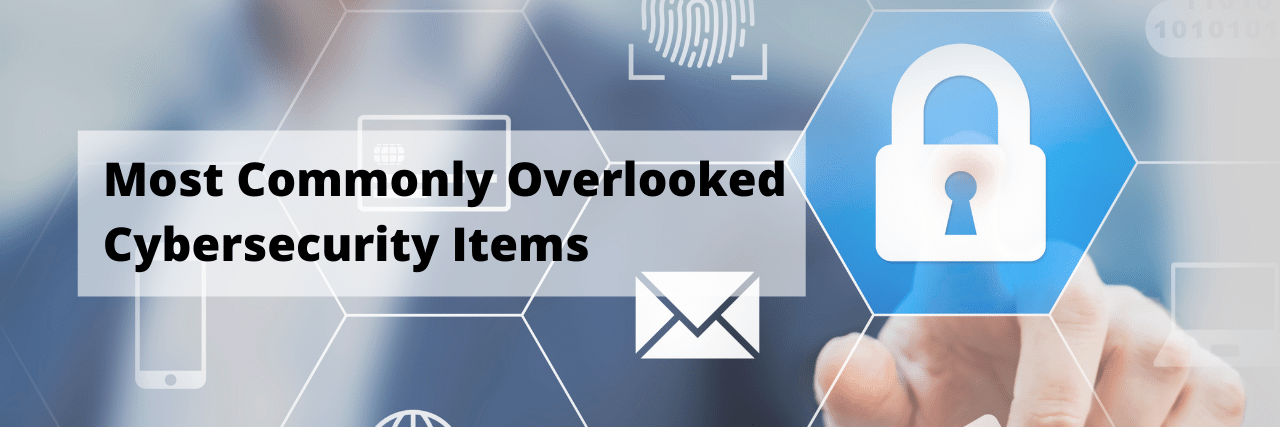Most Commonly Overlooked Cybersecurity Items, and How to Solve Them
April 15th, 2022 | 4 min. read

So you already have the latest cybersecurity tools in place, but your network is still getting breached. What else can you do?
You’ve followed every recommendation from your IT security company, only to find out that your network still had a breach. You might think that just because you’ve implemented the tools, that you’re network is safe, and you don’t have to do anything else. It’s a common misconception.
We know it's frustrating. You're doing everything you can to secure your office environment, but it feels like it's not working. First off, don't be too hard on yourself. Taking security seriously is the first step in creating a safe space. You're on the right track.
The fact is, even implementing a zero-trust security model won't give you 100% protection from potential threats. There will always be blind spots that cybercriminals will try to exploit. Fortunately, if you're already implementing advanced tools and safe practices, you can mitigate the impact of an attack.
All you can do is ensure your security systems are up and your team is practicing safe habits. It will also serve you well to check for your blindspots and confirm you're not overlooking anything.
At ITS, we've helped hundreds of businesses assess their network security and guided them to bolster their defenses. In this article, we'll help you look for your cybersecurity blind spots and other vectors you might have overlooked.
Commonly Overlooked Cybersecurity Items
Implementing multiple layers of cybersecurity and safety practices can be tedious. You have to set up your firewall, antivirus, endpoint detection and response, and so much more. It's easy to overlook some common items that could become a potential entry point for an attack. In fact, even large corporations that spend millions on cybersecurity can experience breaches due to overlooked vulnerabilities.
To help you find those blind spots, take a look at some of the most commonly overlooked cybersecurity items:
 Unsecure Mobile Devices
Unsecure Mobile Devices
Being able to use your own devices for work has become a great boon since the pandemic. It allowed teams to work virtually anywhere, and the practice has actually yielded some great results. In fact, a survey conducted by Cisco found that 69% of IT decision-makers in the US see bring your own device (BYOD) policies in a positive light.
Unfortunately, it also puts your business at risk. Implementing BYOD in your workplace without clear policies and boundaries can leave you open to attack.
How to Resolve It:
Set clear policies and communicate them with your team. Ensure that everyone is aware of the strict conditions of using personally-owned devices. Whether it's limiting the applications, they can install to restricting user access to corporate data, having these boundaries in place will help keep you safe.
 Lax Authorization Practices
Lax Authorization Practices
Ask yourself: who has access to what? Insider threats are becoming more prevalent. According to the Ponemon Institute's 2020 Cost of Insider Threats Global Report, the number of insider threat incidents has increased 47% in just two years. It also found that the overall cost of an incident is rising. The report stated that there was a 31% increase from $8.76 million in 2018 to $11.45 million in 2020.
How to Resolve It:
First, monitor and control all remote access to your data from all endpoints, including mobile devices. You should also implement strict password and account management policies to limit who gets access to what data. You can also implement employee monitoring software to keep tabs on what your team is doing on their devices. Lastly; you need to establish physical security in the work environment. Taking these precautions can help deter insider incidents.
 Ineffective Cybersecurity Awareness Training
Ineffective Cybersecurity Awareness Training
Ask any security expert what their biggest pain point is, and they'll probably answer back that it's human error. An IBM report studying more than 500 cybersecurity breaches occurring between August 2019 and April 2020 found that 23% of all breaches they examined were caused by human error. It's one of the biggest and most common vulnerabilities to your network.
While you might think conducting regular cybersecurity awareness training is enough, you might want to rethink that. In a survey conducted by Forrester Consulting, 50% of IT managers believe they are ticking all the boxes when it comes to security awareness training. However, according to 51% of employees, their IT managers did not stress the importance of good security practices.
That disconnect is the reason many security awareness training efforts fail to meet the mark. They aren't connecting with their audiences.
How to Resolve It:
Teaching people about cybersecurity effectively isn't as simple as going over data points and expecting results. It's about connecting with people and changing their behaviors. The best way to do that is by reframing the message from "do this to keep the company safe" to "do this to keep yourself safe." Focusing on how cybersecurity can affect them instead of the company helps stress how important it is to practice safe habits.
 Lack of IT Governance
Lack of IT Governance
Imagine this scenario: Your IT department is stretched to the limit trying to secure your network. Now, your team is experiencing a bottleneck when it comes to your technology. And worse, some of them are creating workarounds to avoid it. That's called shadow IT, and it's a potential vulnerability.
Shadow IT refers to any project or activity managed without the knowledge of the IT department. One of the biggest reasons employees engage in such activity is often to work more efficiently. According to an RSA study, 35% of employees feel like they need to work around their company's security policies just to get their job done.
It could be as simple as employees using a file-sharing app that wasn't approved by your IT guys. If left unsecured, it could end up as a possible entry point for cybercriminals.
How to Resolve It:
It doesn't matter how advanced your security tools are; if your IT department is stretched too thin, they won't be able to use them effectively. Or, perhaps your IT team doesn't have the expertise to handle everything you need them to. In either case, you should consider growing your team, whether it's getting experts to sign on or outsourcing to a managed service provider (MSP) to fill in the gaps.
Ready to Ensure Your Cybersecurity Doesn't Have Gaps?
There's no tool or service that can promise you 100% protection from cyber attacks. However, that doesn't mean there's nothing you can do to prevent one. Making sure to check your blind spots for vulnerability can help tremendously in keeping your small business safe.
At ITS, we've helped hundreds of businesses assess their networks for vulnerabilities. Download our eBook to learn more about the three types of cyber solutions your business must have.
Mark Sheldon Villanueva has over a decade of experience creating engaging content for companies based in Asia, Australia and North America. He has produced all manner of creative content for small local businesses and large multinational corporations that span a wide variety of industries. Mark also used to work as a content team leader for an award-winning digital marketing agency based in Singapore.
Topics:
